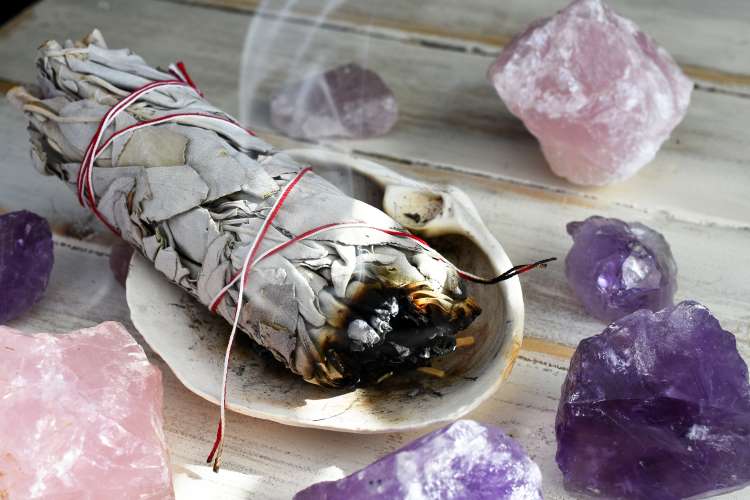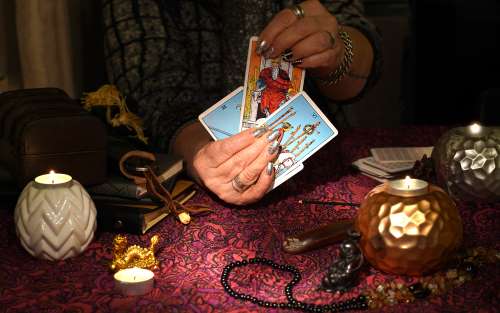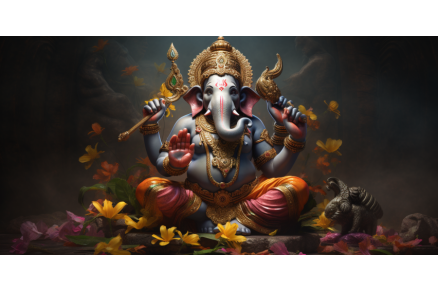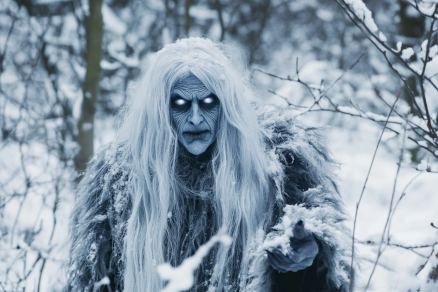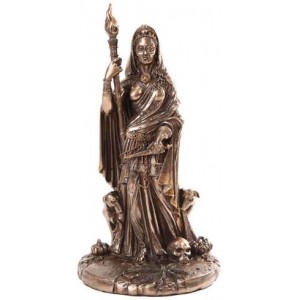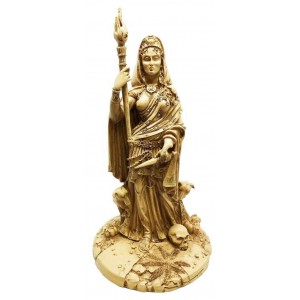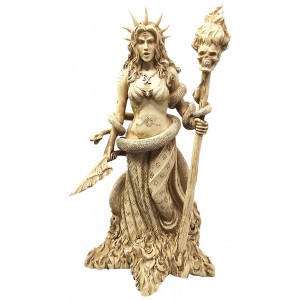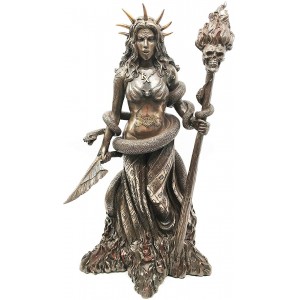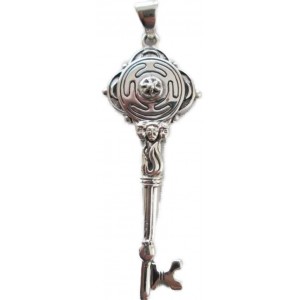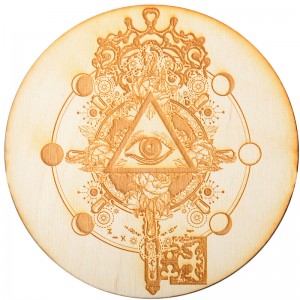Hecate Unveiled: Exploring the History and Mythology of the Witchcraft Goddess
- November 11, 2023
- 1682
- 0
Step into the twilight whispers of ancient myths with the Goddess Hecate, the enigmatic ruler of crossroads, magic, and the moonlit night. She's a figure shrouded in mystery, her torches casting shadows on the pages of history and illuminating paths for those who seek the deeper knowledge of the divine. From her origins in the starlit realm of pre-Olympian lore to her celebrated place in modern pagan worship, Hecate's story is as winding as the roads she governs. Whether you're a curious seeker, a lover of mythology, or a practitioner of the old ways, join us on a journey through the torch-lit corridors of time to uncover the many faces of Hecate. Here, at the meeting of three paths, we'll delve into the heart of her magic, her symbols, and the profound impact she's had on cultures both ancient and new. So, light your candles, still your mind, and prepare to meet the Goddess of the Crossroads.
Hecate: The Mysterious Goddess of the Crossroads
Imagine standing at a crossroads on a moonlit night, the air is still, and the only sound is the whisper of leaves. This is the realm of Hecate, the mysterious goddess who watches over these crossroads.Hecate is the goddess of magic, witchcraft, the night, and, of course, crossroads. Now, crossroads are pretty interesting places. They're where paths meet and decisions have to be made. Do you go left, right, straight, or head back the way you came? And in ancient times, crossroads were seen as spots buzzing with supernatural energy.
Back in the day, Hecate was the one you'd call if you needed a helping hand with some magic. She was the go-to goddess for spells and could whip up a potion for any purpose. But she wasn't just about magic; she was also seen as a protector. She could guide you through tough choices, especially when you were at a metaphorical crossroads in life.
Hecate's symbols are pretty cool, too. She's often shown holding torches, which makes sense since she can light the way when things get dark. She's also associated with keys, which can open doors to hidden knowledge (or just regular doors, which is also useful). And let's not forget her favorite animal companions – dogs. In many stories, she's accompanied by a pack of hounds, which makes her seem even more mysterious and powerful.
The Origins of Hecate: Tracing Back to Pre-Olympian Times
Hecate's story starts way before the Gods of Olympus were worshipped. She's like a relic from a vintage collection, hailing from a time when the world was wilder and the deities were earthier. Her origins are a bit of a mystical mash-up, with hints and whispers coming from various corners of the ancient world.
Think of Hecate (sometimes spelled Hekate) as the original goddess, a divine being who didn't just pop up out of nowhere. She's believed to have come from the lands known as Anatolia, which we now call Turkey. Back then, it was a place bustling with its own gods and goddesses. Hecate was a star there before she became a household name in Greece.
Hecate's parents were said to be Titans - the Gods before Zeus became King of Olympus. Her dad, Perses, was all about destruction, and her mom, Asteria, was the queen of the starry night. With parents like these, Hecate was born to be different. She was the goddess of the night, magic, and crossroads, and she had a knack for seeing into the underworld.
Unlike the other gods, Hecate didn't need a throne on Mount Olympus. She preferred to roam the earth, closer to the humans she was so fond of helping. She was the go-to deity for anything spooky or supernatural. Lost at a crossroads? Hecate was there. Need a love potion or a curse lifted? Hecate had your back.
She's a bridge between the old world and the new, a goddess who didn't just survive a regime change but thrived through it. Her legacy is a testament to her might and her enduring appeal in the tapestry of mythology.
Hecate's Symbols: Torches, Keys, and Dogs
When you think of Hecate, three things should pop into your mind: torches, keys, and dogs. These are powerful symbols that tell us a lot about who Hecate was and what she stood for.Hecate's torches represent light in the darkness, guiding the way. Imagine you're in a pitch-black room and someone hands you a flashlight. That's what Hecate's torches did for people. They were a beacon of hope and guidance, lighting up the night and showing the path for those at a crossroads, both literally and in life's tricky decisions.
Next, let's unlock the mystery of keys. Hecate's got them, and they're not just for opening doors. Keys are a symbol of knowledge and solutions. They unlock secrets, hidden things, and even the future. Having Hecate's keys would be like having the password to every locked diary or secret club. She could unlock the mysteries of the universe and offer insights that no one else could.
Dogs are loyal and protective, and they can sense things humans can't. They were Hecate's faithful companions, barking at ghosts and spirits to protect the living. If Hecate's torches were the light to see by and her keys unlocked all the doors, then her dogs were the ultimate bodyguards, keeping away the bad and scary things that go bump in the night.
The Many Faces of Hecate: Goddess of Magic, Witchcraft, and Ghosts
Hecate isn't your run-of-the-mill goddess; she's a triple threat. Known as the Triple Goddess, she's got three faces, each showing a different aspect of her divine powers. As the goddess of magic, witchcraft, and ghosts, she's a force to be reckoned with.
Let's talk about her magic first. Hecate's brand of magic is the ancient, deep-in-the-forest kind. She's the one you'd find at the center of a swirling mist, conjuring spells that could change your fate. Her magic is about transformation and seeing beyond the world we know. It's the old, whispered secrets of the earth that Hecate holds in her hands.
Then there's witchcraft. Hecate's witchcraft is all about wisdom and understanding the hidden ways of nature. She's the ultimate guide for those who walk the path of the wise. Think of her as the headmistress of an old, mystical school, teaching the arts that mingle with the deepest roots of the earth and the stars above.
As for ghosts, Hecate's connection with them is part of her role as a guide between the worlds. She stands at the gates of the underworld, a lantern in her hand, illuminating the way for the souls who travel to and fro. She's the one who whispers to the spirits and listens to their tales, a mediator between the living and the dead.
But Hecate's triple aspect is about more than just her powers. It's about the stages of life. She represents the maiden, the mother, and the crone, embodying the full circle of life's journey. As the maiden, she's the new moon, full of potential and the promise of beginnings. As the mother, she's the full moon, nurturing and full of creative energy. And as the crone, she's the waning moon, wise and knowing, with a lifetime of experience behind her.
In every role, Hecate is a guardian. Whether it's at the crossroads, by the hearth, or at the threshold of the underworld, she's watching and waiting, ready to lend her light, her protection, and her guidance. She's the keeper of the keys to the universe, the light in the darkness, and the teacher of the ancient ways. With her triple gaze, she sees all and knows much, a deity of depth and mystery.
Hecate's Sacred Sites: Where the Three Roads Meet
Hecate's sacred sites are all about crossroads, those places where you have to decide which way to turn. For Hecate, these aren't just spots to choose whether to go to go right or left; they're powerful places where three roads meet, and magic happens.
In ancient times, people believed that crossroads were spots where you could bump into a god, and Hecate was the goddess you'd most likely meet. They even had a special name for these three-way crossroads: "Hecate's Trivias." "Trivia" here means "three roads," and it was Hecate's favorite place.
People back then would leave offerings at these crossroads, hoping Hecate would stop by and bless them with good fortune or guidance. They'd leave things like food, which was their way of saying "thanks" or "please help" to Hecate.
These sacred sites weren't just about asking for favors, though. They were also places of protection. Hecate was like the ancient world's security guard, and crossroads were her beat. She'd keep an eye out for ghosts or spirits that might be wandering around and guide them away from the living.
But it wasn't all spooky ghost stuff. Hecate's crossroads were also about choices and changes. Standing at a crossroads, people would think about the big questions, like what path to take in life. It was a place for thinking and maybe asking Hecate to shine a little light on the harder decisions.
Whether you needed protection, guidance, or just a moment to figure out your next move, Hecate's Trivias was the go-to place for divine intervention.
The Festivals of Hecate: From Samhain to Deipnon
Two of the most famous festivals for Hecate are Samhain and Deipnon.
- Samhain is an ancient festival that marks the end of the harvest season and the start of winter. It was a time when people believed the veil between our world and the spirit world was super thin and spirits could walk the Earth. This was Hecate's time to shine. As the goddess of ghosts, she was believed to be extra close to the mortal world during Samhain. People would leave food outside their doors as a snack for Hecate and the spirits passing through. It is the basis for our modern Halloween celebrations.
- Deipnon is about cleaning house, both literally and spiritually. It's the Greek version of a monthly reset button. Held during the new moon, Deipnon (pronounced de-pon) was a time to clean up, get rid of any bad vibes from the last month, and start fresh. Families would prepare meals not just for themselves but for Hecate and the less fortunate. It was like a big, community potluck where everyone, including Hecate, was invited. After dinner, leftovers were taken to a crossroads as an offering to Hecate, kind of like leaving a care package at her doorstep.
These festivals for Hecate were about connecting with the divine and taking care of each other. They were times to honor the goddess who could navigate between worlds and who looked out for humans and spirits alike. So, whether it was the ghostly vibes of Samhain or the monthly house-cleaning of Deipnon, Hecate's festivals were all about keeping the balance between the seen and the unseen, the past and the present, and making sure everyone, living or otherwise, was included.
Hecate in Literature: From Shakespeare to Modern Fiction
Hecate has been a muse for writers for centuries, popping up in stories from the quill of Shakespeare to the pens of modern-day authors. She's like a celebrity in the literary world, known for her mysterious vibe and magical powers.
Let's start with the Bard, William Shakespeare. In his famous play "Macbeth," Hecate makes a guest appearance as the queen of the witches. She's the boss, the one in charge, giving orders and making sure the witches' brew is bubbling nicely. Shakespeare's Hecate is all about fate and dark dealings, and she adds a serious sprinkle of supernatural to the plot.
But Hecate's not just hanging out in the past. She's leaped modern fiction, too. You'll find her in fantasy novels, where she's often portrayed as a powerful figure with knowledge of old magic and the ways of the spirit world. She's the character you go to when you need a magical favor or when there's some ghostly mystery to solve.
In some books, Hecate is still guarding those crossroads, helping characters choose their paths. She might be a guiding figure, or sometimes, she's more of a challenge, testing the heroes and heroines as they try to figure out which road to take.
Hecate's presence in literature shows that we're still fascinated by her. She's the go-to goddess for stories about magic and the unknown. Whether she's casting spells in ancient Greece or walking through the pages of modern fantasy, Hecate's literary cameos are always a hit, adding a touch of the mystical to any tale.
The Iconography of Hecate: Depictions in Ancient Art
When you look back at ancient art, Hecate stands out with some pretty distinctive features. Artists back in the day had a field day with her iconography, which is just a fancy way of saying the symbols and stuff they used to represent her.
One of the coolest things about Hecate is that she was often shown with three bodies or three heads. This was to show her power over the crossroads and her role as the Triple Goddess of magic, witchcraft, and ghosts. It's like she could look in all directions at once, which is super handy if you're guarding crossroads or keeping an eye on the spirit world. These triple-formed images of Hecate could be found on statues, pottery, and even coins.
Hecate was also often shown holding key items, like, well, actual keys, which symbolized her role as the keeper of the gates between the worlds. She also held torches to light the way through the dark and sometimes a dagger, a symbol of her ability to cut through illusions and see the truth.
Sometimes, you'd see her with animals, like dogs, because they were her sacred companions. Dogs were seen as protectors, just like Hecate, and they were thought to have a special connection to the spirit world.
In ancient art, Hecate's look was not just about style; it was full of meaning. Every item she held, and every way she was portrayed, told a story about her powers and her role as a goddess. It's like each picture was a mini-lesson in mythology, teaching people about the mighty Hecate without them having to read a single word (after all, most people could not read in ancient times).
Hecate's Role in the Myth of Persephone and the Underworld
In the myth of Persephone and the Underworld, Hecate plays a super important role. When Persephone, the daughter of the goddess Demeter, was snatched by Hades and taken to the Underworld, it was a big deal. Imagine the chaos when the goddess of springtime disappears into the land of the dead.
Hecate, being the goddess who can travel between worlds, heard Persephone's cries when she was abducted. She's got this amazing ability to hear things others can't, especially when it comes to cries for help. So, when Persephone was calling out, Hecate was one of the few who actually heard her.
But Hecate didn't just sit there; she sprang into action. She lit up her torches, which are like the ancient world's flashlights, and helped Demeter search for her missing daughter. She was the search party's guide, holding the torch high and leading the way through the darkest corners of the earth.
Once Persephone was found in the Underworld with Hades, Hecate stayed by her side. She became Persephone's companion during her stay in the Underworld, kind of like a mentor. This wasn't just about keeping her company; Hecate was there to support and guide Persephone as she adapted to her new role as the queen of the Underworld.
Hecate's role in this myth shows her as a friend and guide, someone who's not afraid of the dark and can navigate the scary places others wouldn't dare to tread. She's the light in the darkness and the friend in times of need. Her part in the story of Persephone and the Underworld is a testament to her powers and her kind, guiding spirit.
Modern Worship of Hecate: The Revival of Pagan Traditions
In recent times, there's been a big resurgence in the worship of ancient gods, and Hecate is no exception. This revival is like a renaissance for pagan traditions, and Hecate is getting a lot of attention as a goddess for the modern age.People today are drawn to Hecate for her connection to nature, magic, and the spiritual world. She's seen as a powerful figure who can help navigate the complexities of life, much like she guided folks at the crossroads in ancient times. Modern worshippers might not leave food at the crossroads like in the old days, but they do perform rituals to honor her, seeking her guidance and wisdom.
Hecate's modern followers often gather during the full moon, which is kind of her favorite time. They hold ceremonies that might involve lighting candles, which is a nod to her ancient torches, and offering prayers or spells that they believe Hecate can empower. It's like having a monthly meeting with a wise mentor to get some advice on life's big questions.
Another way Hecate is worshipped today is through environmentalism. Since she's connected to the earth, her modern worshippers see taking care of the planet as a form of devotion. They might plant trees, clean up beaches, or work in gardens, all to show respect to Hecate and her domain.
The revival of Hecate's worship shows that old gods can have new life in modern times. Her followers see her as a symbol of empowerment, especially for those who feel a connection to the mystical side of life. Hecate's comeback is about blending ancient wisdom with contemporary concerns, proving that some deities just never go out of style.
Hecate's Herbal Magic: Plants Associated with the Goddess
Hecate's herbal magic is all about the plants that are linked to her, and let me tell you, she's got quite the green thumb. These aren't just any old plants you'd find in your backyard; they're special herbs that have been associated with Hecate's magic for centuries.- Aconite, also known as wolfsbane. This plant is seriously powerful and pretty dangerous. In ancient times, it was used in potions and spells, but always with a lot of caution. Aconite is like the heavyweight champion of magical plants, and it's said that Hecate can handle it like a pro.
- Belladonna, which has a name that sounds pretty but is also known as deadly nightshade. It's got a rep for being a witchy herb, perfect for visions and protection spells. But just like aconite, you don't want to mess with it unless you know what you're doing. Belladonna is like the secret agent of plants—mysterious and a bit risky.
- Garlic is another one of Hecate's go-to's. But it's not just for keeping vampires away or adding flavor to spaghetti. Garlic is all about protection. People would use it to guard against evil spirits and bad luck. It's like the bodyguard of the herb world.
- Yew is a tree that's often linked with Hecate. Its berries and needles are super toxic, but it was used in ancient times for rituals, especially those to do with the afterlife. The yew tree is like the old, wise one in the forest that's seen a thousand years come and go.
- Mint is a lighter, friendlier plant in Hecate's herbal arsenal. It's said to help with healing and protection, and it's a lot safer than some of the other herbs on this list. Mint is like the nurse of the plant world, always ready to help out.
- Cypress is another tree sacred to Hecate, often planted in graveyards. It's a symbol of mourning but also of eternal life. Cypress trees are like the stoic guardians of sacred spaces, standing tall and offering comfort.
These plants and trees are all part of Hecate's herbal magic kit. They're symbols of her power over life, death, and the mystical in-between. But remember, just because they're plants doesn't mean they're all friendly. Some of these herbs are as tough and complex as Hecate herself.
The Protective Hecate: Guardian of the Home and Travelers
Hecate isn't just about spooky crossroads and ghostly whispers; she's also known as a protector, kind of like a supernatural bodyguard.For the home, Hecate is like the ancient version of a security system. Back in the day, people believed that placing an image of Hecate, known as a Hecateion, near their front door or in the hearth would protect their home from bad energy and evil spirits. It's like she was keeping an eye out for trouble, making sure everyone inside was safe and sound.
And it wasn't just homes she was looking after. Hecate was also the goddess for travelers, especially those who had to move around at night. Remember, there were no streetlights back then, so having Hecate on your side was like having a personal guide through the darkness. Travelers would pray to her before they set out, hoping she'd light their way and keep them safe from bandits or wild animals.
Hecate's protection wasn't just about keeping the baddies away, though. She was also about guiding people through transitions. Life's full of changes, and Hecate was there to help people through those times. Whether it was a big move, a new job, or any other life shift, Hecate was the one you'd want in your corner.
So, Hecate's role as a protector shows a softer side to this powerful goddess. She's not just about the mystical and the magical; she's also about keeping folks safe and guiding them through the ups and downs of life. Whether you're staying in or heading out, Hecate's the divine guardian you'd want on your team.
Hecate's Animals: From Serpents to Owls
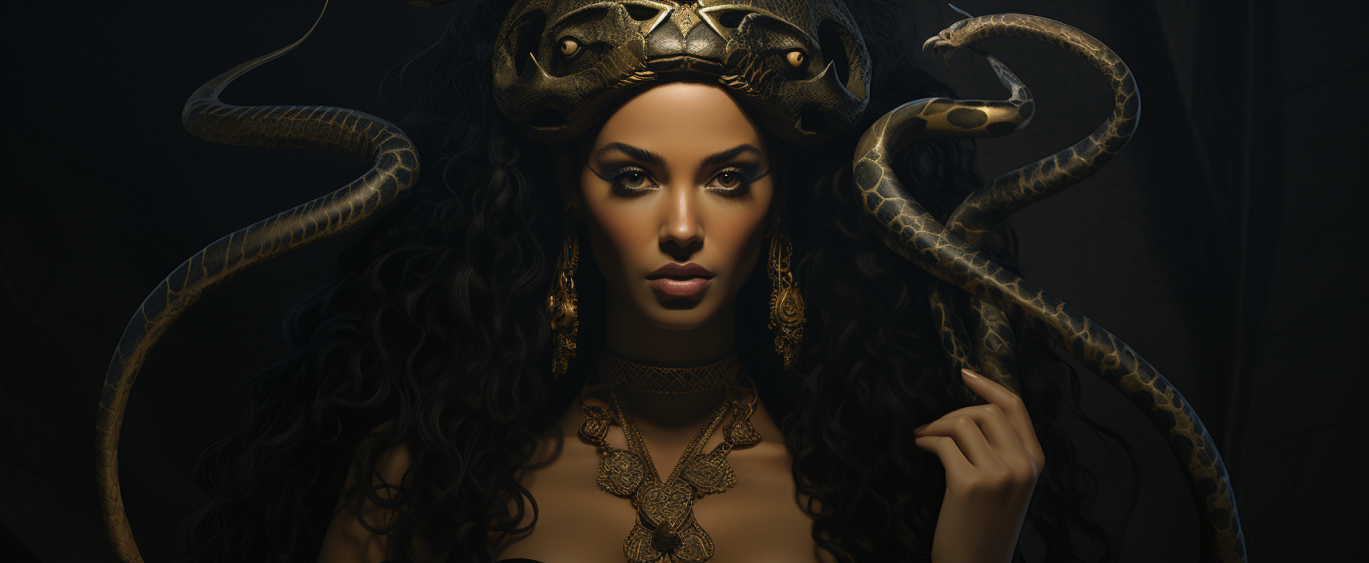
- Dogs. They're her number one, her loyal companions. In many stories, you'll hear about dogs barking to let everyone know Hecate is near. They're like her personal alarm system. Dogs also represent protection and the ability to sniff out the truth, which are big deals for Hecate.
- Serpents: Serpents are all about rebirth and renewal because they shed their skin and come out all shiny and new. They're like the symbol for starting fresh, which is something Hecate is all about.
- Owls: These birds are not just about being wise, although that's a big part of it. Owls can see in the dark, which is super handy for a goddess who's into the night and all its mysteries. Owls represent seeing beyond the obvious, knowing what's hidden, which is right up Hecate's alley.
- Frogs: It might seem a bit weird, but frogs are all about transformation. Think about it: they start as tadpoles and then turn into frogs. It's a big change, and change is something Hecate knows a lot about.
- Horses: They're not just for getting around; they represent freedom and power, which are qualities Hecate has in spades.
Each of these animals brings a different flavor to Hecate's divine table. They're not just pets; they're symbols of her rule over magic, transformation, and the unseen world. So, when you think of Hecate, picture her surrounded by this menagerie of meaningful creatures, each one a piece of her powerful puzzle.
Invoking Hecate: Rituals and Spells for Modern Witches
Invoking Hecate is a big deal for modern followers who are into her vibe of magic and mystery. They use rituals and spells to get in touch with her, and it's not just about waving a magic wand and saying some magic words. It's about respect and knowing what you're doing.
One popular way to reach out to Hecate is by setting up an altar. This isn't your everyday kitchen table setup. It's a special space where you put symbols of Hecate, like keys for her role as the guardian of the crossroads, torches to represent her light in the darkness, and images or statues of her. The best positions for altars to Hecate are near the front door or near the hearth where she can protect and guide.
Then there's the Deipnon, which is a fancy word for a monthly dinner party that's all for Hecate. It happens during the new moon, when the night is at its darkest. Followers whip up a feast and share it with Hecate and the less fortunate. It's like a potluck where everyone, including the goddess, is invited. Cooking or serving at a homeless shelter is a great way to honor Hecate's role as a protector in our modern world.
Another ritual is the lighting of candles or torches. Remember, Hecate is big on light in the dark, so this is a way to honor her. Followers light candles to symbolize her presence and to ask for her guidance. It's like turning on a flashlight to show the way through a dark room.
Spells for Hecate often involve protection or guidance. Her followers might use herbs associated with her, like lavender for peace and protection, and say specific chants. These spells are like asking Hecate for a favor, whether it's for keeping safe on a trip or making a big decision.
But here's the thing: invoking Hecate isn't a game. It's serious stuff. Modern witches believe she's a powerful ally, and they treat these rituals with a lot of respect. It's about connecting with her on a spiritual level and asking for her help in a way that's been done for thousands of years, just with a modern twist.
Hecate: A Powerful Goddess with Ancient Roots
As we've journeyed through the mystical realms of Hecate's world, from her ancient origins to her modern-day worship, it's clear that her influence is as enduring as it is profound. Hecate's story weaves through the tapestry of time, touching on everything from her role at the crossroads to her presence in literature, her protective nature, and the animals sacred to her. We've explored how she's celebrated in festivals, depicted in ancient art, and how her symbols and rituals have evolved to remain relevant today.
Hecate's essence, captured in the rituals and spells of those who honor her, continues to resonate with those seeking guidance, protection, and transformation. Her legacy, rich with symbolism and steeped in the power of the natural and supernatural worlds, endures as a testament to her complexity and significance in a modern context that still looks to the wisdom of the past for inspiration.
Whether as the Triple Goddess of Maiden, Mother, and Crone, the guide through life's transitions, or the keeper of the keys to the universe, Hecate remains a multifaceted figure of empowerment and mystery. Her story is a reminder that ancient gods and goddesses like her still hold a place in our collective consciousness, inviting us to explore the depths of our intuition and embrace the magic that whispers at the crossroads of our lives.
Related Posts
The Meaning of the Triple Goddess: Unveiling the Profound Mysteries
- 1449
- 0
The Triple Goddess, with her three facets—Maiden, Mother, and Crone—has been my constant companion, guiding me through the seasons of my own life. She's whispered in the rustling leaves of spring, cra..
Exploring the Mythology and Teachings of Ganesha
- 1359
- 0
With an elephant head, a pot belly, and a mouse as his ride, Ganesha is not your everyday deity. Let's dive into his mythology, symbolism, and modern worship, and see what makes him one of the most fa..
The Cailleach: Ancient Celtic Winter Goddess
- 1123
- 0
The Cailleach, revered throughout the ancient British Isles, is one of the most enigmatic and powerful figures in Celtic mythology. Known as the Winter Goddess or Divine Hag, she embodies the harsh, c..

